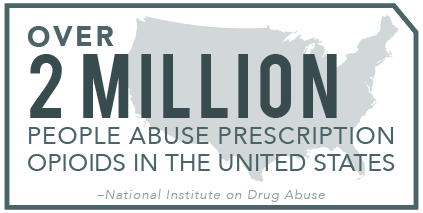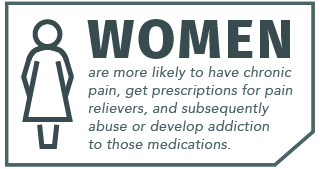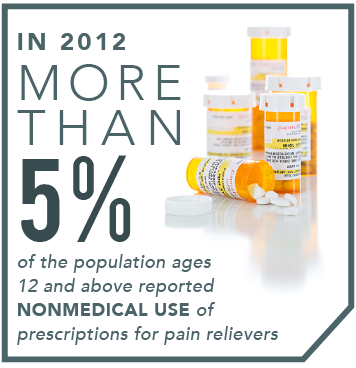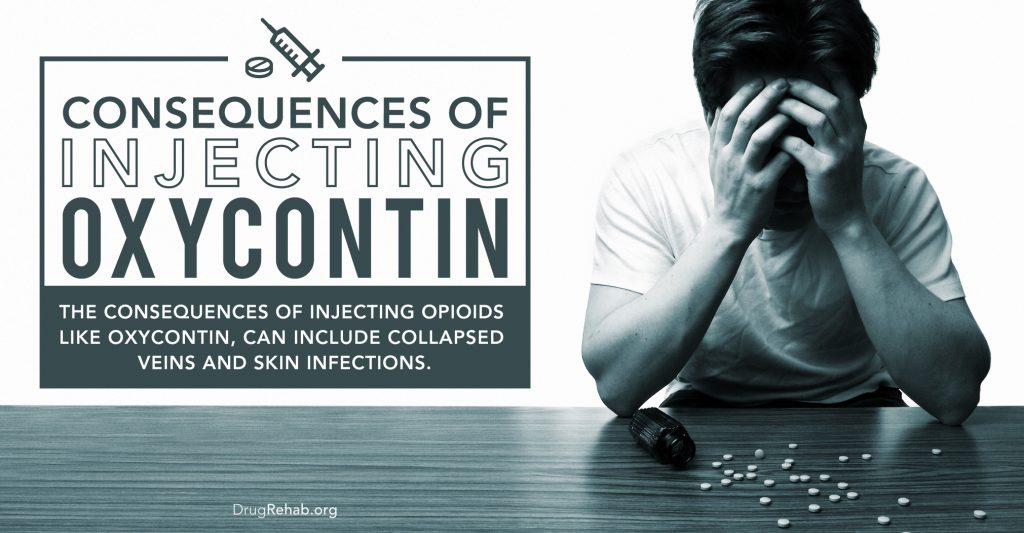What Happens When You Inject OxyContin?
There are many ways to abuse drugs.When you’ve fallen victim to addiction, the fastest way to attain a high is usually the one you seek. Injecting is one of the quickest ways to get high. Administering drugs through injection into the muscle or directly to the bloodstream ensures quick results—the “rush” feeling.
Many prescription drugs like OxyContin (oxycodone) are designed for a slow release of effects. Injecting OxyContin allows you to skip the waiting period, producing an immediate rush. Unfortunately, abusing the drug in this way also comes with consequences.

As the Center for Substance Abuse Research (CESAR) explains, when abusing OxyContin, “the risk of an overdose increases dramatically since the drug is not intended to be used in this manner.” Also, many who abuse it may pair it with abuse of other substances like alcohol, which can be a dangerous combination.
But these negative outcomes aren’t the only adverse effects. Injection of any drugs can cause you health risks, and addiction to prescription drugs like OxyContin can affect your health and other aspects of your life.
What Are The Risks?
Some risks of abuse by injection include:
- Bacteria on the cardiac valves
- Cardiovascular infections
- Damage to veins: collapsed or inflamed veins
- Puncture marks or track lines at the injection sites
- Infections of the skin, such as abscesses or cellulitis
- Swelling in feet, legs, and/or arms due to poor blood flow
What Are The Signs Of Addiction?
OxyContin is the brand for Oxycodone, which is a prescription opioid. Opioid prescriptions are used to treat moderate to severe pain, and many of these drugs are highly addictive. OxyContin is no exception. In fact, like other opioids, it is typically prescribed only for a short time to help avoid abuse.
However, even if you take the drug for only a short period of time, you can develop addiction to it. Here are some signs to look for if you suspect you may be falling into addiction:
- You take the drug more often than prescribed
- You change the method of administration to get quicker results (such as crushing the tablets and injecting instead of taking orally)
- You experience strong cravings for the drug
- You can’t get the same effects from one dosage, and start taking more (tolerance)
- You experience physical side effects when you aren’t taking the drug (withdrawal)
While addiction may be avoided if taking a prescription drug exactly as prescribed, the possibility of becoming addicted to the effects of opioids is high. It’s important that we all take part in fighting prescription drug abuse: following directions for prescriptions, not sharing our medications, making sure we know the risks associated with our medications, and more.
For those who need help with addiction, treatment for opioid abuse is available, and has proven to be effective. Treatment is the single best way to safeguard against continued drug abuse and the effects it can have on your life.
Where Do People Get OxyContin?
OxyContin is a prescription pain reliever; in short it has to be prescribed. This is where many of us can become susceptible to the dangers of addictive prescriptions. We don’t always realize the risks of medications because we assume they are intended to help us get better.

Many medications can be helpful. Opioids can be the only relief for people experiencing severe pain and ailments. But they can also be harmful when abused, and if you aren’t aware of the dangers it can be all too easy to fall into abuse.
Prescription Opioid Abuse
Prescription opioid abuse is a problem that has expanded in recent years. The National Institute on Drug Abuse (NIDA) reports that over 2 million people abuse prescription opioids in the United States. Globally, abuse of opioids (the larger group of opiates which includes prescription opioids and illicit drugs like heroin) affects anywhere from 24 to 36 million.
Opioids affect the brain by attaching to opioid receptors and changing the way our brains respond to pain. The brain adapts to this new way of responding to pain, and begins seeking these results again and again through cravings.
Once you have become addicted, you may find you experience withdrawal symptoms when not taking the drug. Some withdrawal symptoms are moderate, but others may be severe enough that you don’t want to be without the drug. Withdrawal is what keeps many addicted, along with tolerance.
Tolerance happens when your brain no longer responds to the drug like it used to. While your brain may not feel the effects, your body can only process so much of the drug at a time. It’s in this way that you risk overdose. Forcing too much of a drug on your body or forcing the drug to work more quickly or differently than it should is dangerous, and can be fatal.
Who Is Affected?
Perhaps it seems like we should have prescription opioid abuse under control, but the truth is we simply don’t. The NIDA explains that in 2012 more than five percent of the population ages 12 and above reported non-medical use of prescription opioids.

Teens may be at increased risk simply because they can easily gain access to prescriptions through family members or friends. Women also are more likely to have chronic pain, get prescriptions for pain relievers, and subsequently abuse or develop addiction to those medications.
What Can We Do About Prescription Opioid Abuse?
There are a few measures we can all take to prevent prescription opioid abuse, both for ourselves and others. First, always take medications only as prescribed, never increasing dosage or method of administration without talking with a doctor.
We can also keep medications in a secure place, and keep track of the dosage to be sure no one else is using them. Lastly, we can work to inform teens and children of the dangers of prescription drug abuse, opening conversations to share information and discuss safe medication practices.
If you or someone close to you is struggling with prescription opioid abuse, you can find the help you need in treatment. We at DrugRehab.org are here to assist you on this journey, and make the transition to healing as easy as possible.
Treatment Options
There are many different methods of treatment at your disposal when you are ready to take that first step and enter a rehabilitation center. Opioid addiction treatment first requires detoxification, which allows your body to dispose of the chemicals acquired during abuse.
Our rehab centers offer medically supervised detoxification to help you succeed in this process. They may also implement medication assisted therapy to help ease the symptoms of withdrawal. After detox, you can begin therapy, counseling, and any combination of methods that are right for your individual needs.
Our rehab centers will work with you, designing treatment goals that meet your specific needs. Just a few of the evidence-based methods we offer include:
- Treatment for men’s unique needs
- Treatment for women’s unique needs
- Cognitive Behavioral Therapy
- Dialectical Behavioral Therapy
- Medication Assisted Therapy
- Counseling—individual, family, group
- Fitness and nutrition help
- Assistance with aftercare
Find The Help You Need
If you have been struggling with injecting OxyContin, then you already know it can be hard to stop abuse. We want to help you put this difficult time behind you, and begin a new part of your life. Contact us today at DrugRehab.org to learn more about prescription opioid abuse, our renowned rehab centers, and the best treatment options for you.
For More Information Related to “Consequences Of Injecting OxyContin (Oxycodone)” Be Sure To Check Out These Additional Resources From DrugRehab.org:
- The Dangers of Snorting Oxycontin (Oxycodone)
- Heroin and Opioid Addiction Statistics
- Drug Addiction And The Brain
- Snorting, Smoking, or Injecting Drugs: Which Gets You Addicted
- Understanding A Heroin Use Disorder
Sources
Drug Free World—OxyContin The “Hillbilly Heroin”
Mayo Clinic—Oxycodone (Oral Route): Side Effects
U.S. Food And Drug Administration—OxyContin Questions And Answers



